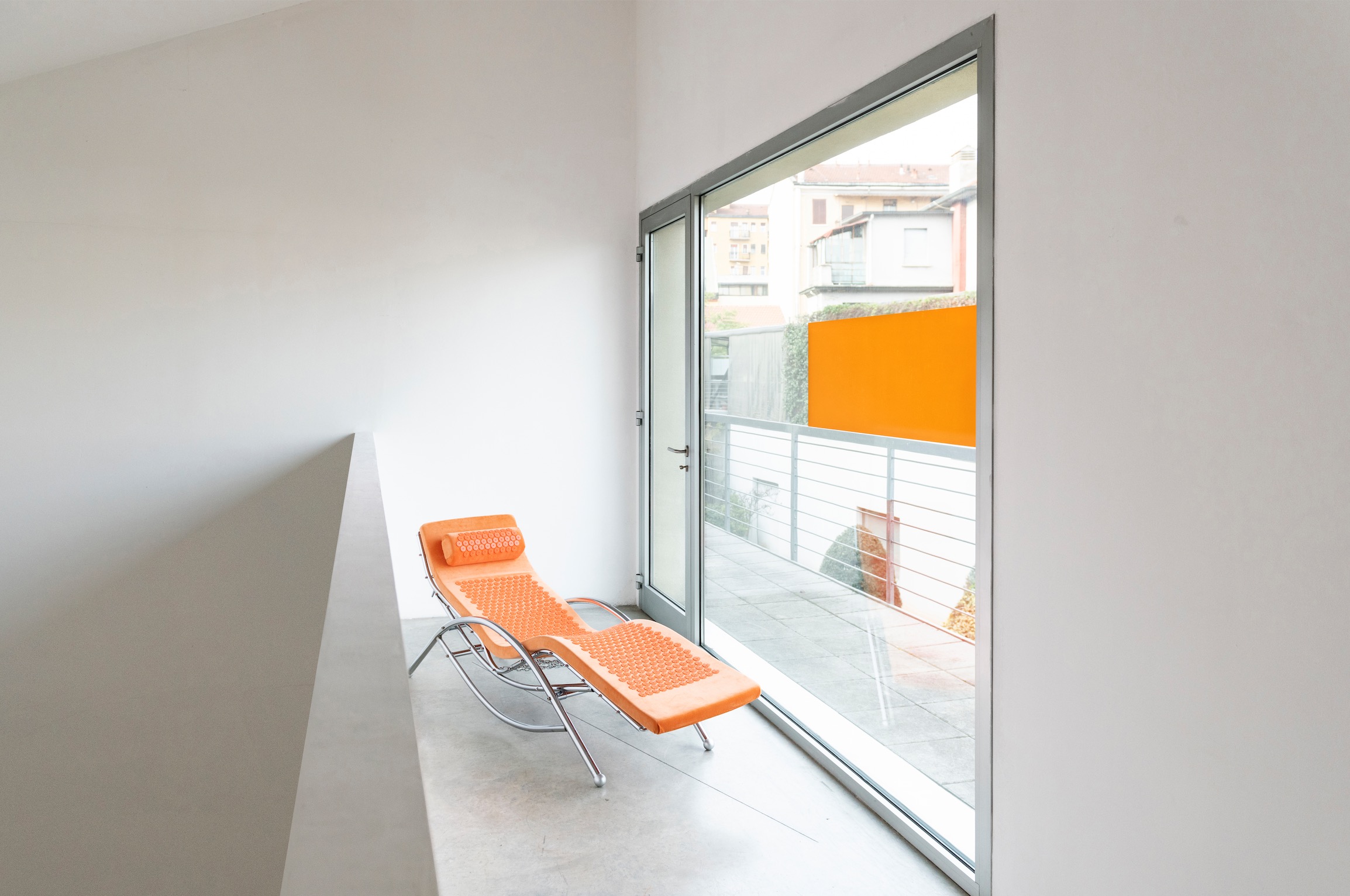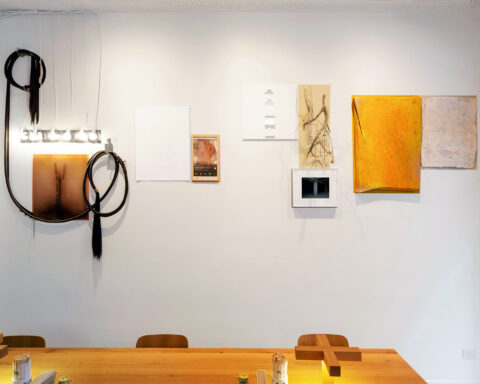Everywhere you go there you are is the first solo show in Milan of the young Austrian artist Sophie Hirsch (1986, Vienna), visible until 15 January 2023 at Galleria Doris Ghetta.
Social relationships are the main focus of Sophie Hirsch’s research: as a doctor with their patients, Hirsch examines the nuances, ways and difficulties of human interactions, creating paroxysmal spaces of hybrid reflections in which both the physical and psychological components emerge.
The solo show highlights the complementarity of physical and mental wellness, aiming to raise awareness in the audience on the importance of the balance between the two, tearing down the indolent super-humanism typical of nowadays’ culture. In today’s world, characterised by fast paces, people can be everywhere (“Everywhere you go…”), and get to have almost everything without the need to stop and reflect on the processes that govern the society they live in. The coronavirus pandemic has shown plainly that people found themselves unprepared when forced to slow down and reflect on who and where they were (“…there you are”). The exhibition proposes an experiential path similar to a rehabilitation.
The artworks realised by Sophie Hirsch are hybrid and undefined elements between art and design and the entire set-up reminds of the futuristic and utopian environments designed by the spouses Alison Margaret and Peter Denham Smithson in 1956 with their House Of The Future.
The exhibition commences in a room with four chairs and a sofa, placed around a small glass table. This setting represents the permeation of the public and private spheres: the viewer might have the impression of being inside a domestic and private living room (still the most sociable and representative room inside a house), as well as in the waiting room of a public building. In this ambiguous room, all the pieces of furniture are fabricated using orthopaedic devices typically employed to correct body posture as myofascial balls, Thera-bands, extension springs and orthopaedic cushions.
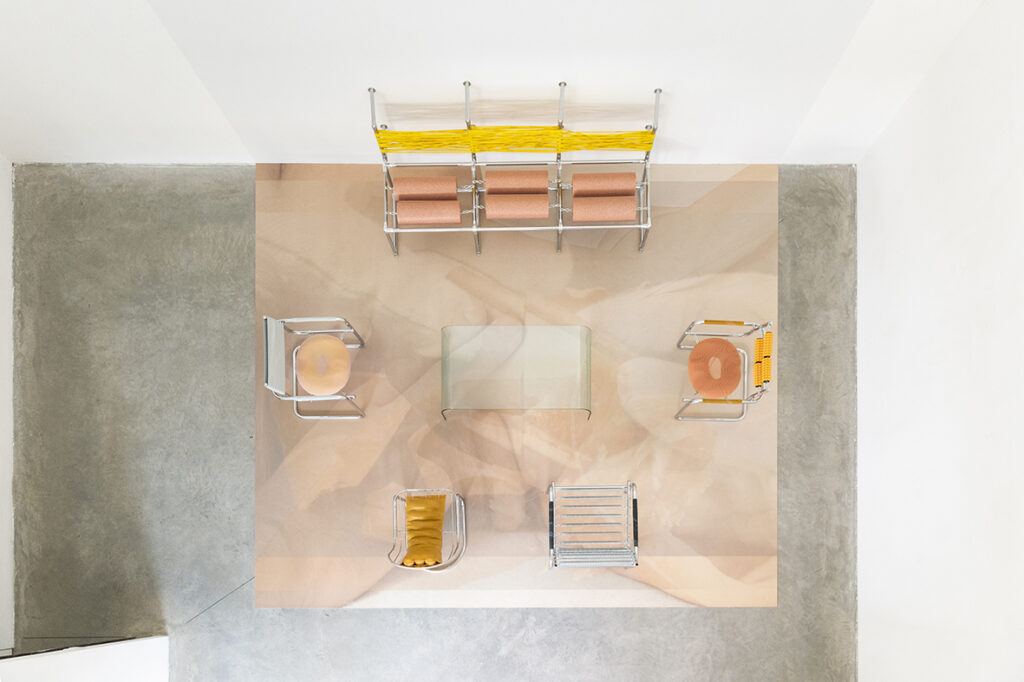
The artist’s strategy in choosing how to display her artworks challenges the expectations of the usual public of a gallery, that in this case is engaged through a different and unconventional perspective. When entering the exhibition, the audience bumps into a scientific experiment, almost turning into a test animal. The set-up leverages the familiarity of the furniture, whose approachable aspect, versus that of a strict sculpture, is an invitation for interaction. In this way the furniture serves as an entryway into the rest of the exhibition. An opener, a conversation starter for the viewer with the works as well as for the viewer with other visitors. How does each chair feel? What parts of the body become vocal? Where is the discomfort and where is the release? In this way the chairs ideally open up a sensibility that is a sort of preparation for carrying on with the rest of the exhibition – a way to relate to the internal in order to better relate to the external.
What makes the game work is the feeling of trust that the audience grants to the artist, and that allows to take on the challenge and discover more.
The colours of the furniture are appealing and inviting, but their shapes, on the contrary, are irritating and vaguely absurd. Overall, the room is filled with a thin but perceivable tension, and does not appear comfortable nor attractive. The artist, however, invites the audience to move beyond a first-sight impression.
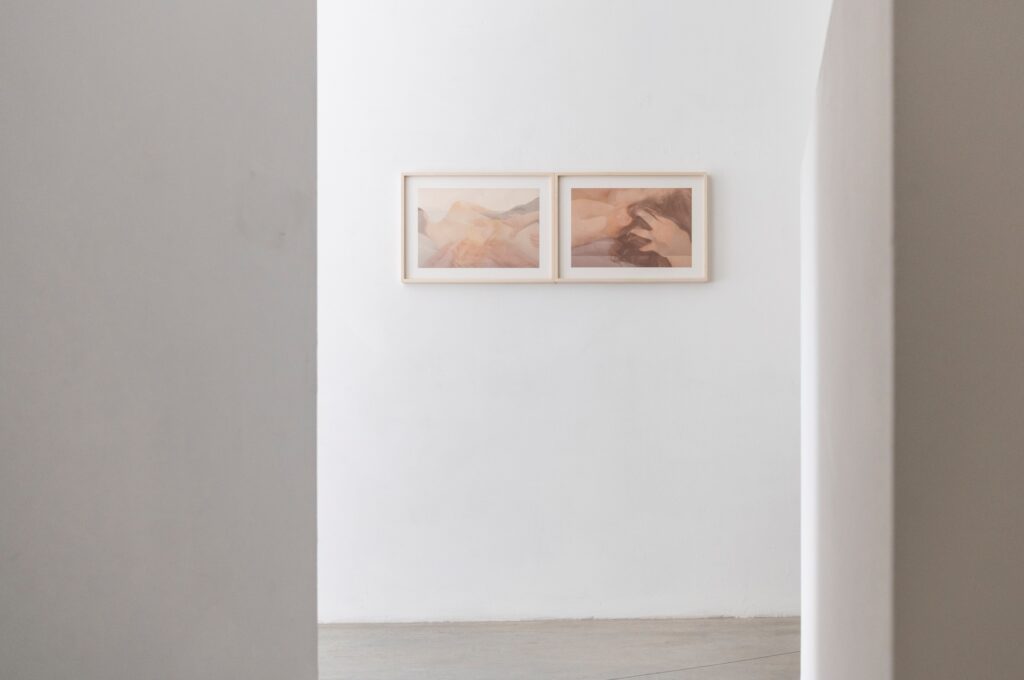
In her works, Sophie Hirsch makes abundant use of contrasts that evoke a feeling of discomfort. In this case, the feeling of discomfort is used by Sophie Hirsch in various layers and combinations, designing an allegorical path that the audience has to follow.
The first layer stems from a physical collision, the moment the audience encounters the chairs made of orthopaedic devices. Each item is made of elements characterised by an unusual state of tension and apparent precariousness. The spectator decides to trust Sophie Hirsch and to sit down on the chairs trying to get comfortable: the state of tension and precariousness becomes real – due to the instability of the structure, the consistency of the materials and their lack of adaptability to the body, the visitor requires some seconds to search for an optimal balance and position. This is also what happens in design showrooms, where people try different chairs and sofas in order to choose the most comfortable ones.
The second layer of discomfort employed by Sophie Hirsch has to do with social interaction, and it has a hybrid nature that could be labelled as psychosomatic: once visitors are sat down, the conversation between them is disturbed by the uncomfortable posture of their bodies on the chairs. In this situation, all the interlocutors are in a constant search for physical balance and – each time from a new starting point – they try to reach calmness and deal with each-others.
The third and last layer of discomfort stems from the environment in which the visitors move: the exhibition space is composed of wise formal games, that remind of the minimalist practice and depict an aseptic and unrelated place. This is the case, for example, of the geometrical arrangement of the spaces highlighted by abstract and visual elements, bright orange and reddish shapes, realised by the artist, together with their modular interaction.
Moving towards the first floor – an inner balcony overlooking the ground floor – the audience faces new elements that stimulate again discomfort and repulsive feelings and enhance once more the artist’s focus on the body. On the stairway leading up to the first floor, the audience is overwhelmed by a large silicone fabric (Untitled, 2022), a seemingly organic appearance that is both fascinating and repelling, desirable and disgusting, with its reddish veining reminding of an open wound. Silicone is often found in Hirsch’s works, a material that takes on the characteristics of human fascia, storing the information of the surfaces it touches while maintaining flexibility.
The silicone fabric appears in front of the audience as a terrifying epiphany with an intense symbolic meaning, conveying tension but also drawing the attention to the details of the technic chosen by the artist. This artwork also marks a shift in the exhibition path to a more introspective dimension.
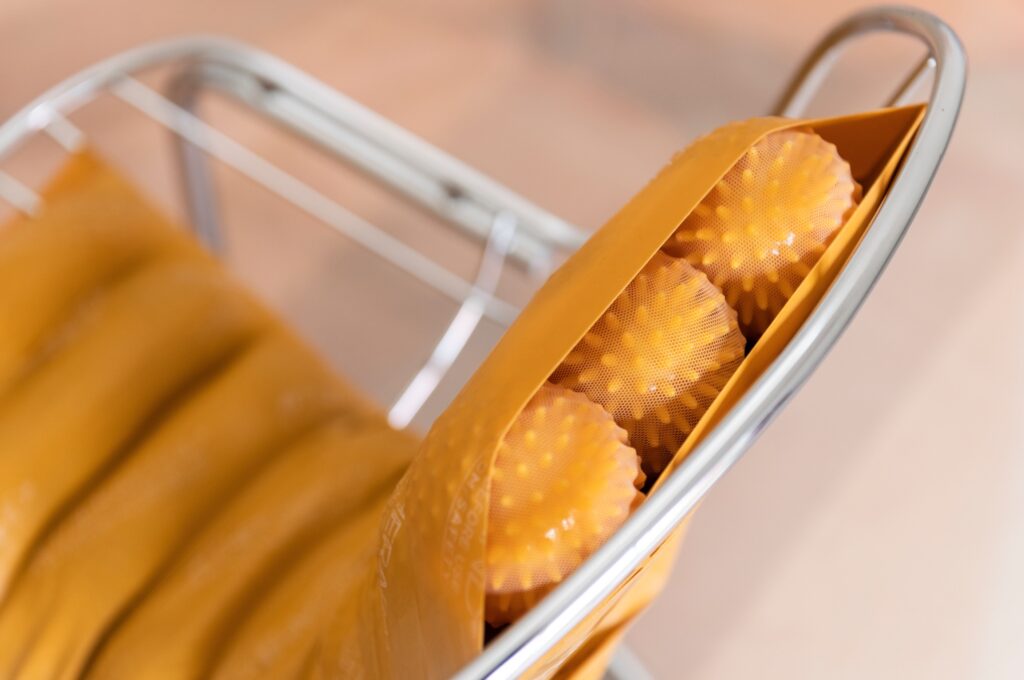
Ideally, the first floor should represent the triumph of the private sphere versus the more sociable one that characterises the ground floor. Contrasts and tensions remain central: the wall of the inner balcony hosts some framed photo collages; on the other side, an orange chaise longue is covered with acupuncture spikes. The two photo collages, titled Reinforcing the Dissonance and Misguided Self Preservation (2022), investigate the feelings associated to the experience of the body and the psychological behaviours, depicting physiotherapy practices and blurred fragments of body parts.
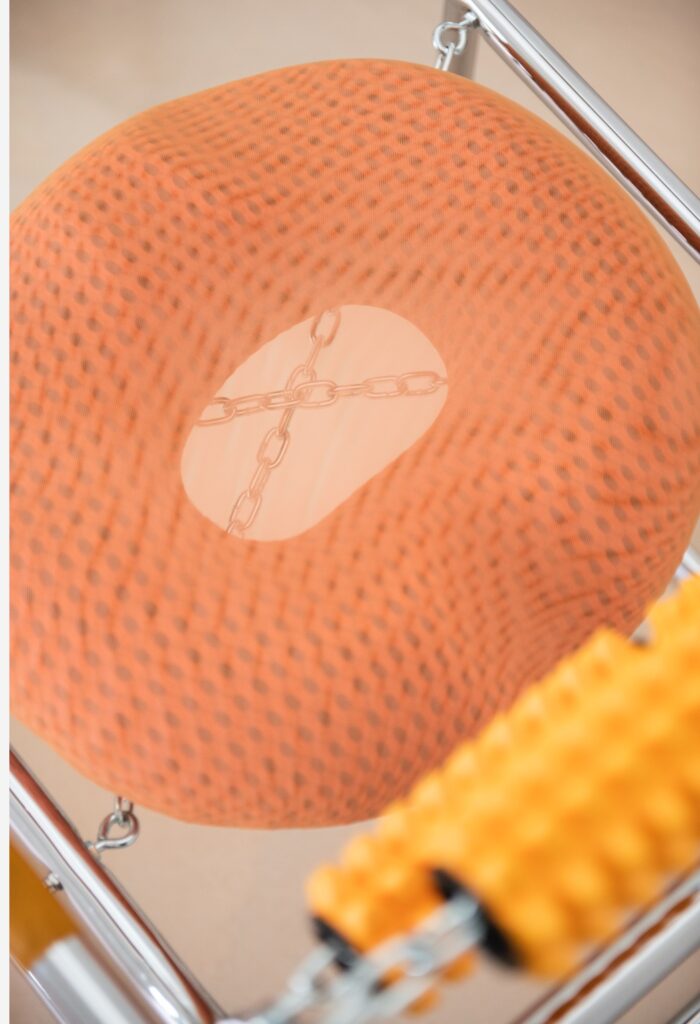
The chaise longue – located between a large French door and the balcony railing – reminds of a psychotherapist’s couch and allows the visitor to isolate from the other people in the room and meditate on his path through the exhibition, as well as on life outside the in-vitro world created by Hirsch. Lying on the chaise longue, the visitor relaxes and takes a moment to cope with his emotions and concentrate on breathing, before returning downstairs (an agora-like space) to re-socialise with others.
The entire exhibition path looks like a game of strategy designed by the artist: on the ground floor, the pieces of furniture composed of stacked myofascial balls and extension springs create progressively unstable structures such as in the game of Jenga; on the first floor, after having been part in the artist’s experiment, the visitor can isolate and contemplate from above the experimental and dystopian scene of the ground floor – as a deus ex machina. Through this privileged sight, the visitor is invited to meditate and the game becomes conceptual. In this role play, Hirsch pushes the audience to reason on how the world outside is changing, especially after the coronavirus pandemic, and how our relationships have become more difficult and inconvenient.
Everywhere you are there you are represents an authentic still frame of the times we live in, building an encounter between oxymorons, contrasts, the complementarity between psyche (soul, mind) and soma (body), and the importance of searching for self-balance. Under a schematic sight and through the creation of an in-vitro context, the exhibition investigates how people relate with each others and live their personal and meditative moments in the same way a music score alternates adagio, allegro and pauses.
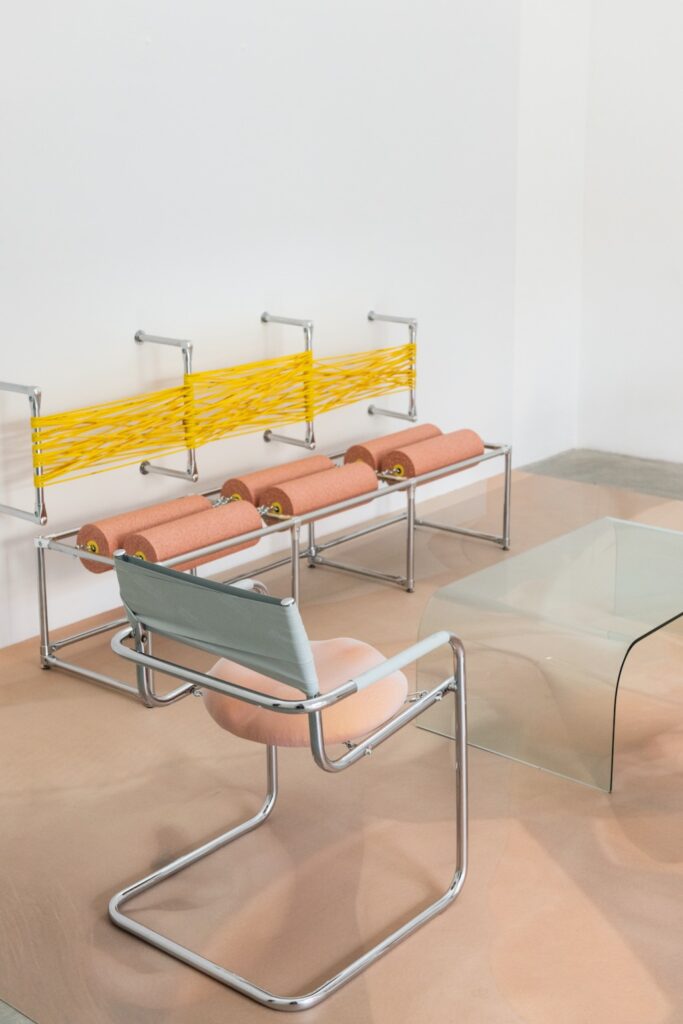
Through the set-up and the evocation of a hybrid environment between the private and the public (or medical) spheres, Sophie Hirsch analyses essential themes for the contemporary: the idea of care, that is both physical therapy and the attention to mental wellness and relationships; the concept of living, and the correlated feeling of belonging in the context of nowadays precariousness. With this solo show, the gallery as institution has partly moved away from its commercial vocation, privileging the creation of a space of horizontal relationships, immersive, and sociable.
Due to the coronavirus pandemic and the war crisis, contemporary society is renegotiating equilibria that were previously given for granted: Sophie Hirsch embraces this tension, that she presents both as a force that can paralyse thoughts and movement, as well as a vital source of productive exploration.


